Several softwares described here are also available on ATSAS online (registration required).
Dummy atoms bead modelling with DAMMIF
Dummy atoms bead modelling is used to generate 3D models corresponding to experimental SAXS data.
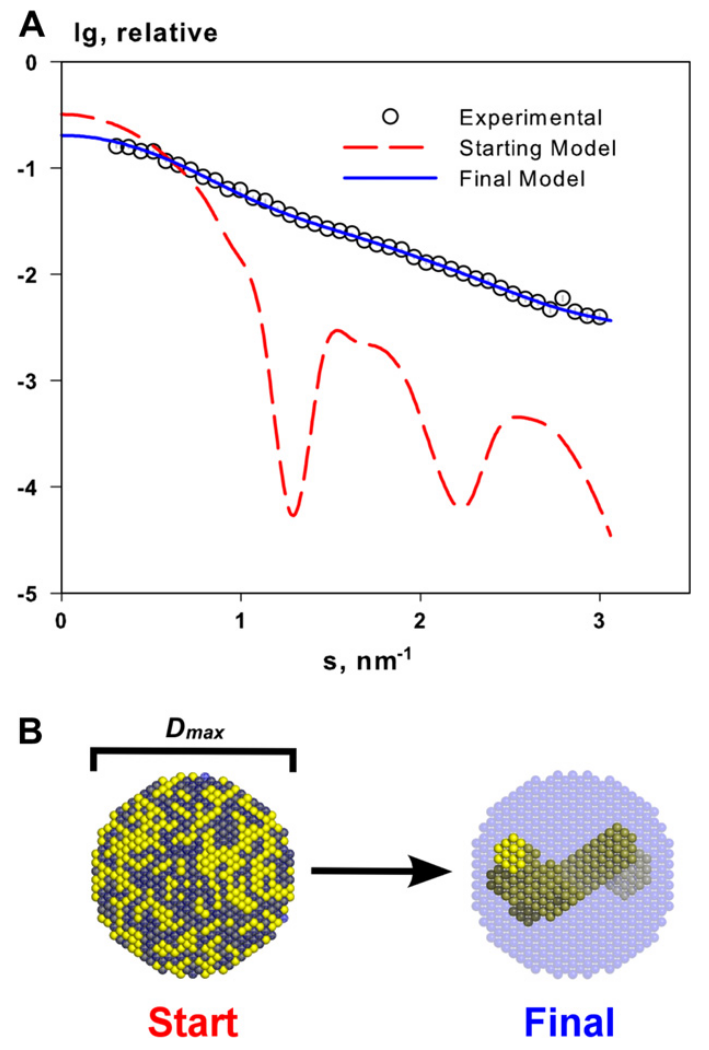
Source: Mertens and Svergun 2010
Citing the manual of DAMMIF, the general process goes as follow:
In bead modeling a particle is represented as a collection of a large number of densely packed beads inside a search volume. Each bead belongs either to the particle or to the solvent. Starting from an arbitrary initial model DAMMIF utilizes simulated annealing to construct a compact interconnected model yielding a scattering pattern that fits the experimental data.
More details, and the official manual for ATSAS DAMMIF can be found here.
Overview of the process
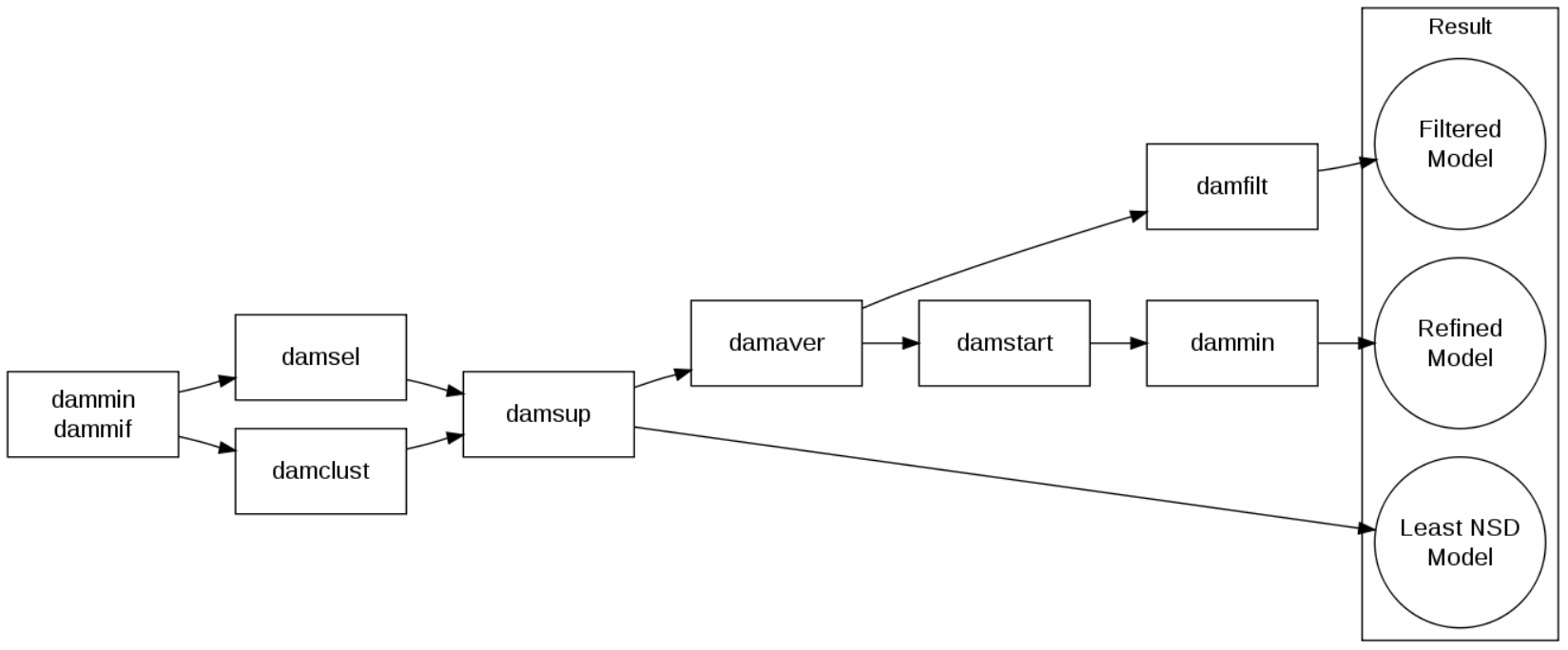
Source: Franke 2012
DAMMIF/DAMMIN via RAW
RAW offers a nice GUI for running ab initio dummy atom modelling from SAXS data. If you rather run DAMMIF et al. from the command prompt, go to the next section. Otherwise, in RAW, right-click on the GNOM .out file and select Bead Model (DAMMF/N). This will open a new dialog window.
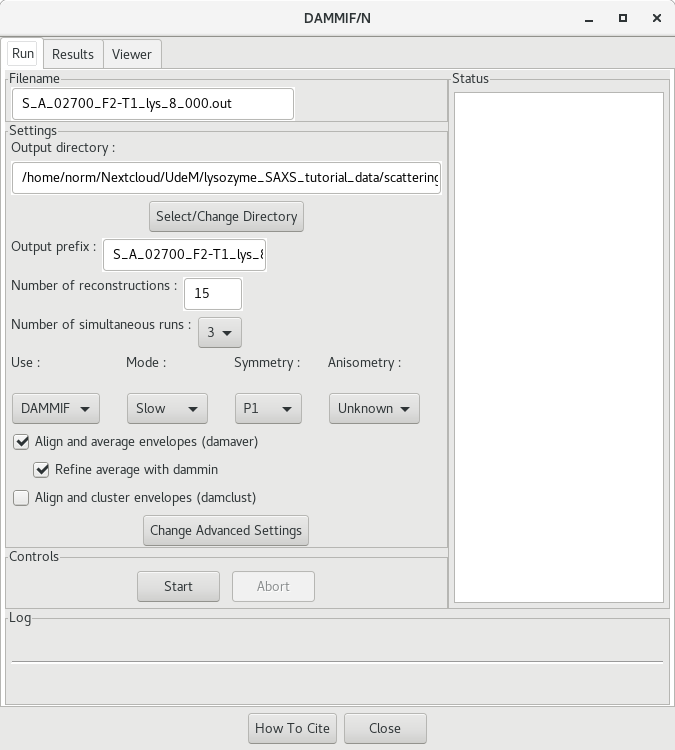
Change the output directory to the DAMMIF directory
<project_name>/processed_data/DAMMIF/
You can also change the prefix name. At this point, file names will become very long! Other parameters to adjust, depending on the quality of the model and time you want to invest, include:
| "Type" of modelling | Quick and dirty | Good | Ultimate |
|---|---|---|---|
| Time to calculate | Minutes | Hours | Days |
| Number of reconstructions | 10 | 20 | 100 |
| Mode | Fast | Slow | Slow |
| Refinement with DAMMIN | no | yes | yes |
| Clustering with DAMCLUST | no | no | yes |
Then click on Start to initiate the calculations. This will take some time, depending on the complexity of your sample and the speed of the processor of your computer (CPU). We recommend that you run these on one of our Linux machine in the computers room.
Please keep in mind that a "quick and dirty" modelling approach will not yield a publication quality model. The objective here is to quickly generate a dummy atoms model in order to give a broad idea of the shape of the molecule investigated. The Fast mode uses larger bead atoms and the cooling time during the annealing step is faster. It will therefore likely generate a lower accuracy model.
DAMMIF with refinement
DAMMIF generates several models trying to fit the experimental data. However, following selection (DAMSEL) and averaging (DAMAVER), the model will not fit the experimental data well. This bead model should therefore be refined via DAMSTART and DAMMIN (by selecting the Refinement with DAMMIN option).
More below.
The result will look like this:

RAW also outputs a CSV file (lys_8_dammif_results.csv in our case) containing the data presented in the table above. Additionnaly, a PDF file (lys_8_dammif_results.pdf here) is printed where the resulting SAXS profile of each model is fitted to the experimental data.
The log file of the DAMMIN procedure (refine_lys_8.log) will also contain the final Chi2 against the experimental data at the bottom (use the tail refine_lys_8.log command to only read the last lines of the log file):
Final Chi^2 against raw data ........................... : 1.446
The final, refined DAMMIF/N dummy atom model can be found at the file name refine_lys_8-1.pdb and can be visualized by your favorite molecular viewer (e.g. PyMOL).
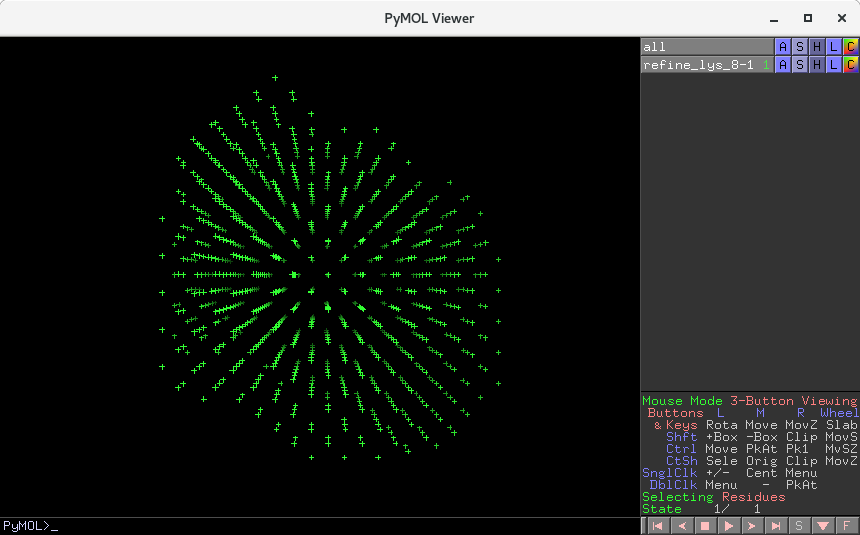
In order to see the model with "beads", enter the following commands in the PyMOL prompt:
hide all
show spheres

More about model visualization in the section below.
DAMMIF with refinement and DAMCLUST
DAMMIF generates several models trying to fit the experimental data and can be further clustered in groups of similar shapes with DAMCLUST. This is relevant when several (20 or more) models are generated by DAMMIF, in order to provide representative models (there could be more than one possible solution!) and assess the ambiguity of the modelling results.
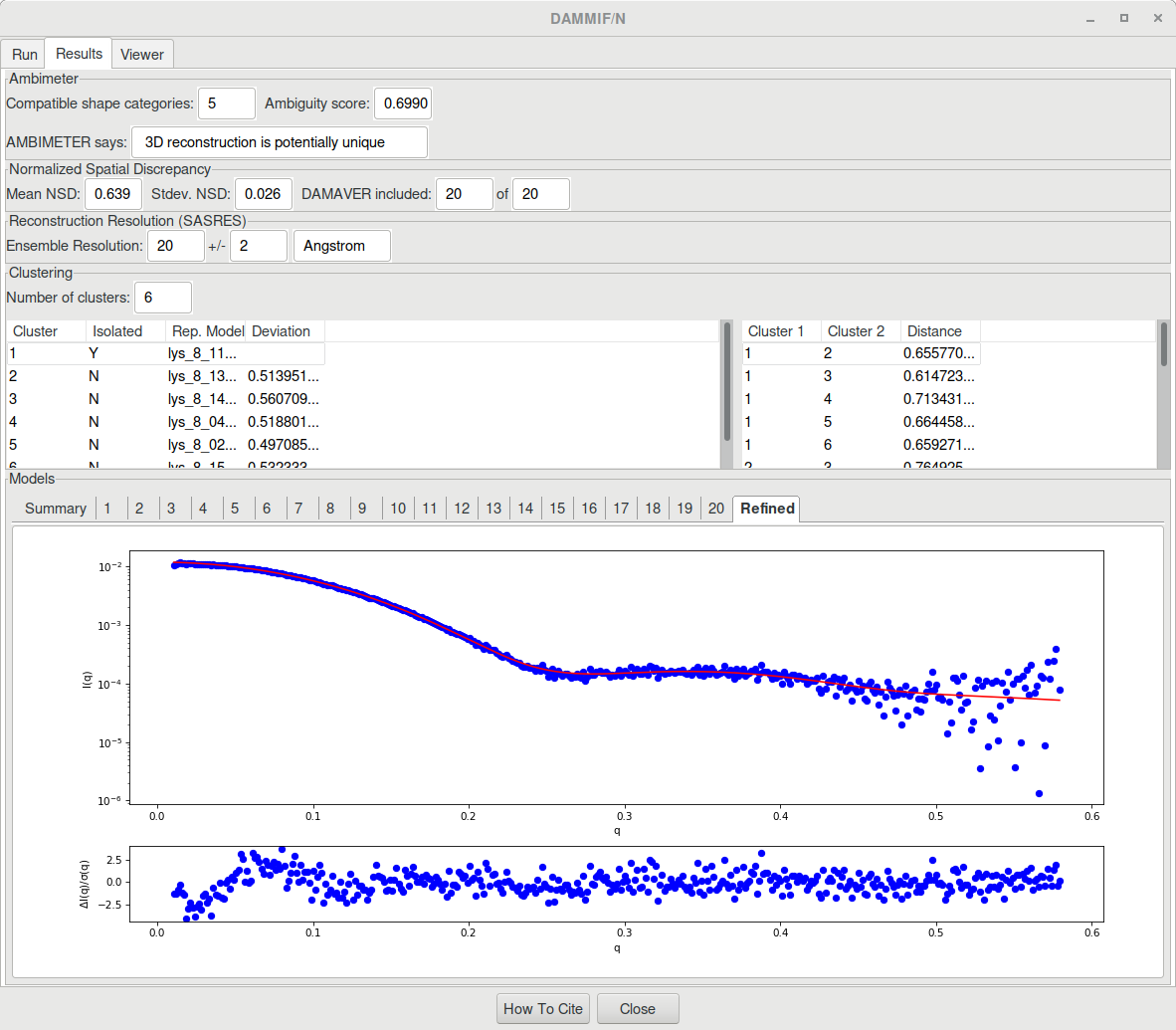
I suggest that you inspect the DAMCLUST log file (lys_8_damclust.log in the present case). You will find all the relevant information regarding clustering statistics:
Cluster 1 (isolated): lys_8_11-1.pdb
Cluster 2 (representative, deviation): lys_8_13-1.pdb 0.51395155614075694
The cluster contains 2 members. Equivalent model: lys_8_07-1.pdb
Cluster 3 (representative, deviation): lys_8_14-1.pdb 0.56070984352458797
The cluster contains 2 members. Equivalent model: lys_8_12-1.pdb
Cluster 4 (representative, deviation): lys_8_04-1.pdb 0.51880126381182456
Other cluster members:
lys_8_16-1.pdb
lys_8_01-1.pdb
lys_8_05-1.pdb
Cluster 5 (representative, deviation): lys_8_02-1.pdb 0.49708589875970327
Other cluster members:
lys_8_18-1.pdb
lys_8_09-1.pdb
lys_8_06-1.pdb
Cluster 6 (representative, deviation): lys_8_15-1.pdb 0.53233381087953957
Other cluster members:
lys_8_20-1.pdb
lys_8_03-1.pdb
lys_8_19-1.pdb
lys_8_10-1.pdb
lys_8_17-1.pdb
lys_8_08-1.pdb
Distances between the representatives
(Cluster1, Cluster2, Distance):
1 2 0.65577070756240063
1 3 0.61472311767972543
1 4 0.71343199569634563
1 5 0.66445856740754217
1 6 0.65927117113398515
2 3 0.76492541385778356
2 4 0.60028264458406144
2 5 0.79368600384055565
2 6 0.59647682130412460
3 4 0.69334851364429495
3 5 0.56016424546682719
3 6 0.70273685297916710
4 5 0.69956301946692123
4 6 0.57830157185833553
5 6 0.66991966464588559
DAMCLUST will also generate an average model for each cluster. The averaged models of each cluster can then be refined with DAMMIN and used for structural analysis. This step needs however to be performed via the command prompt. See details here.
DAMMIF/DAMMIN via the command prompt
Will later be updated to use the files available in the tutorial
Initial DAMMIF calculations
DAMMIF uses the GNOM output file (the distance distribution function) as the main input file. It has two modes of operation (fast - large beads and slow - small beads) as well as an interactive mode (invoked by running only dammif without arguments).
The general command is
dammif --mode=fast lys_8.out
This will output a single bead model in PDB format along with a log file and numerical files containing fits to the experimental data. Generally speaking, it is common to calculation multiple models and then average the similar ones. This is done using a for loop in a bash script (see below).
Below is a typical bash script to determine 20 models simultaneously, in slow mode:
#!/bin/bash
# Variables used
GNOM_FILE_PREFIX="lys_8"
MODE="slow"
NB_CALC=20
# Loop for the program
for i in `seq 1 $NB_CALC`
do
dammif ${GNOM_FILE_PREFIX}.out --prefix=${GNOM_FILE_PREFIX}-${i} --mode=$MODE &
done
Averaging and filtering
A series of softwares are available for selecting the most similar models (DAMSEL), aligning the selected models (DAMSUP), averaging them (DAMAVER) and then filtering to a cut-off volume (DAMFILT). A complete manual is available online.
Exclusion of significantly different models with DAMSEL
DAMSEL selects the most probable models from a series of bead models generated by DAMMIF (or GASBOR) and identifies outliers using SUPCOMB, a software used for the superposition of PDB models. The models are scored using a normalized spatial discrepancy (NSD). The SUPCOMB manual describes the process in the following terms:
Briefly, if two three-dimensional models are represented as a set of points, for every point in the first set (model 1), the minimum value among the distances between this point and all points in the second set (model 2) is found, and the same is done for the points in the second set. These distances are added and normalized against the average distances between the neighboring points for the two sets.
For well superimposed models, NSD will gets toward 0, whereare a NSD above 1 corresponds to models systematically different. With DAMSEL, models which NSD exceeds 2 standard deviations from the mean of the group of models are labelled as excluded.
The general command is
damsel lys_8-1-1.pdb lys_8-2-1.pdb lys_8-3-1.pdb lys_8-4-1.pdb ...
By default, the results will be written in the damsel.log log file, with the following format:
Recommendation NSD File
Include 0.605 lys_8_15-1.pdb
Include 0.605 lys_8_10-1.pdb
Include 0.608 lys_8_03-1.pdb
Include 0.611 lys_8_17-1.pdb
Include 0.611 lys_8_08-1.pdb
...
Below is a typical bash script to run DAMSEL:
#!/bin/bash
# Variables used
DAMMIF_PREFIX="lys_8"
OUTPUT_LOGFILE="damsel.log"
damsel ${DAMMIF_PREFIX}-*-1.pdb -o $OUTPUT_LOGFILE
Alignment of selected models with DAMSUP
Using the list of included models output by DAMSEL, the next step is to align the models to a reference one (typically the first one). This is done using DAMSUP via the following command:
damsup damsel.log
Alternatively, a list of PDB files may be given:
damsup lys_8-1-1.pdb lys_8-2-1.pdb lys_8-3-1.pdb ...
The letter r is added at the end of the file names for structures that were aligned to a reference. A table giving the NSD to the reference will be saved in damsup.log:
NSD Filename
0.000 lys_8_15-1.pdb
0.519 lys_8_10-1r.pdb
0.470 lys_8_03-1r.pdb
0.540 lys_8_17-1r.pdb
0.551 lys_8_08-1r.pdb
...
Averaging with DAMAVER
DAMAVER will then take the aligned models from DAMSUP (using the output log file) and calculate a probability map. The software writes this frequency per atom as occupancy in the output file, damaver.pdb.
damaver damsup.log
The output average model can further be filtered using DAMFILT at a given cut-off volume. Therefore, low occupancy and poorly connected atoms are removed. The cut-off volume used is the averaged volume of the models if available, or half the input volume otherwise.
damfilt damaver.pdb
Refinement of the model using DAMMIN
The filtered model generally does not fit well the experimental data. It is therefore highly recommended to refine the model against the experimental data using DAMMIN. To do this, a starting model has to be generated with DAMSTART:
damstart damaver.pdb
This generates a fixed core model (damstart.pdb) that will be used as an initial approximation, instead of starting the modelling with a sphere with a diameter of . For refinement purposes, DAMMIN has to be run in interactive mode (run the command dammin alone) where each parameter is entered one by one. Line-by-line answers may be saved in advance in a text file and input (<) into the dammin command (more details here and here).
dammin < answers.txt
The complete manual for DAMMIN can be found here.
Visualization of the models
Suggestions are provided on the SAXIER forum: